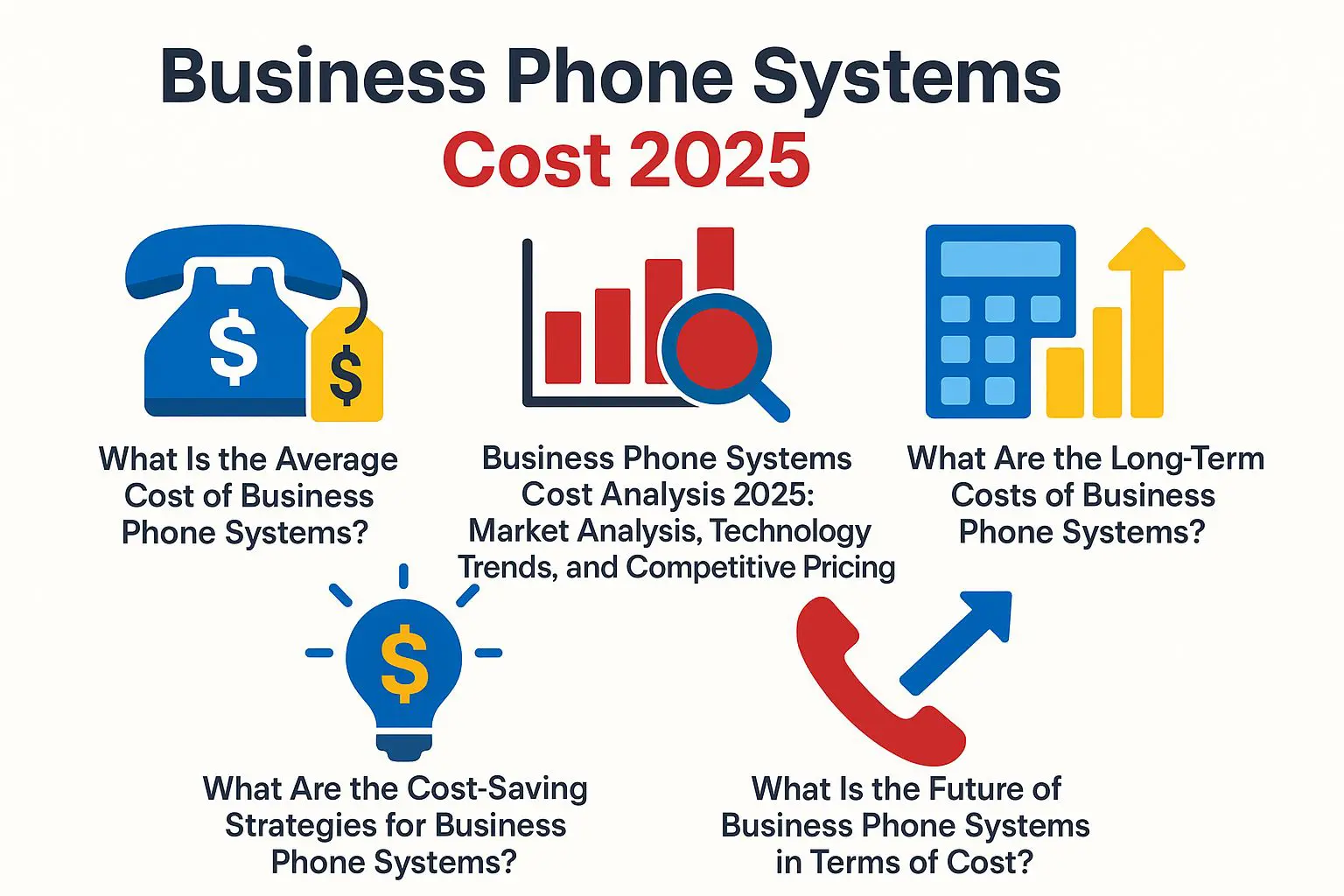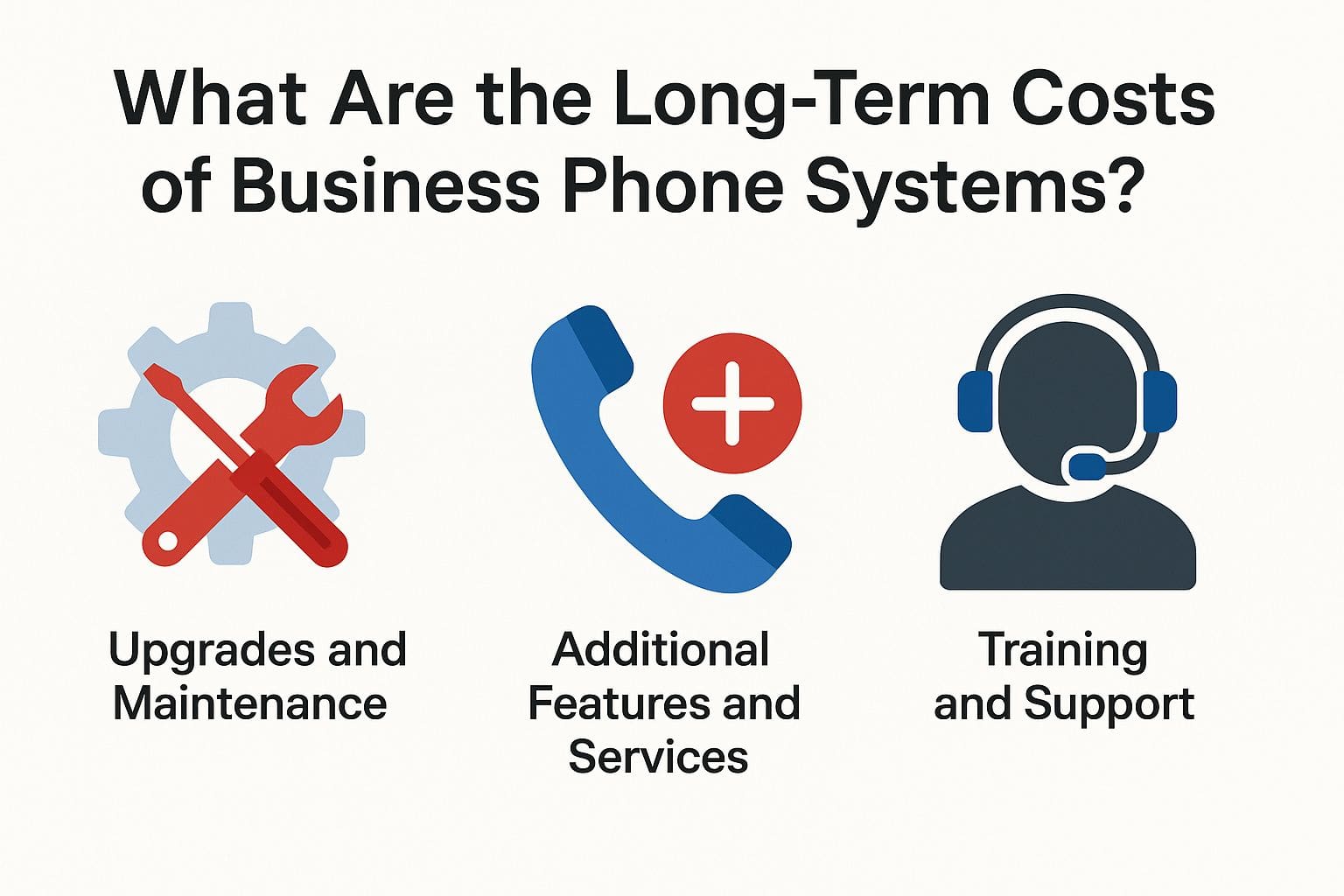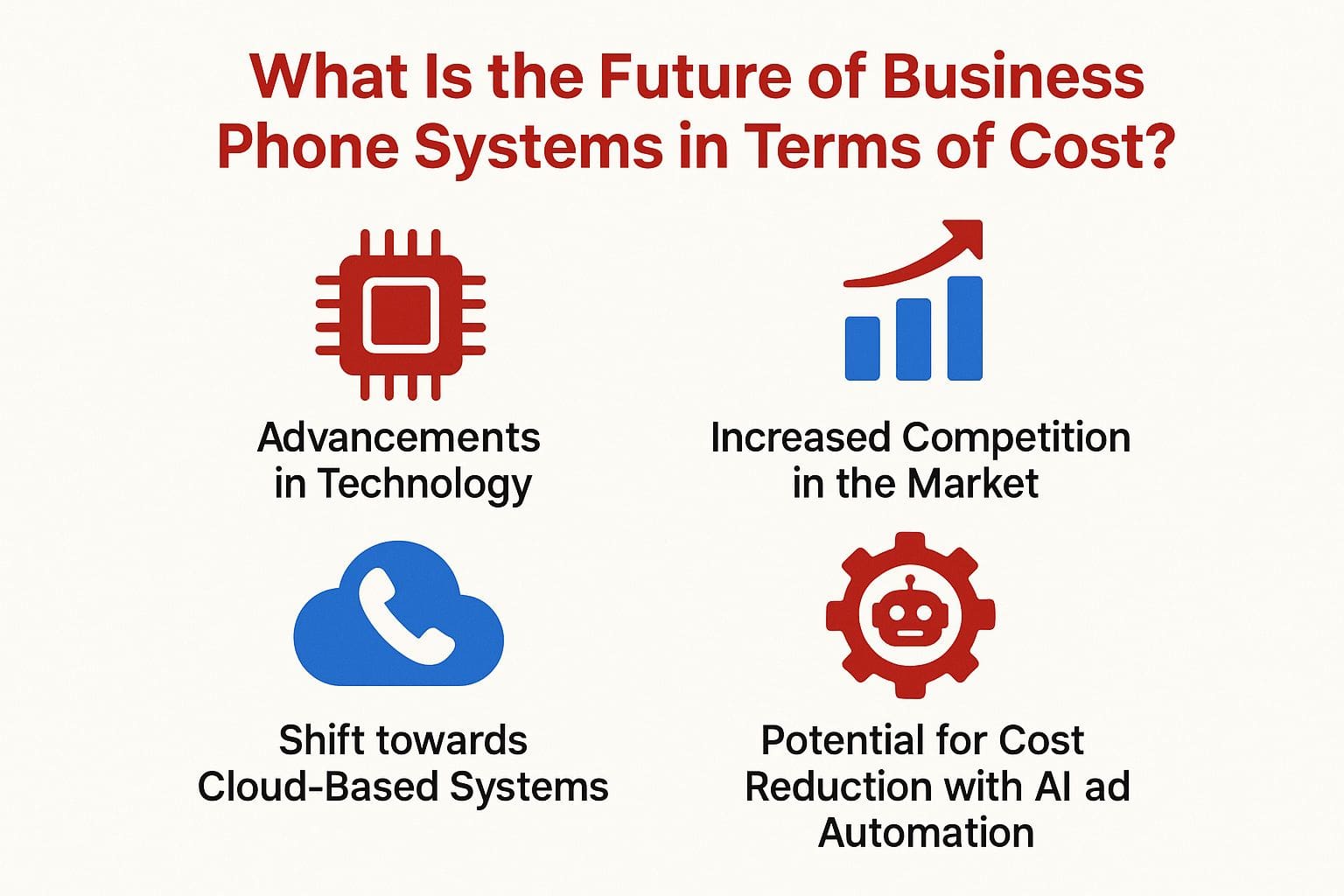
How Much Do Business Phone Systems Cost in 2025? (Updated June 18, 2025)
Learning about business phone systems can be challenging, especially when figuring out the details of business phone systems costs involved.
From on-premises PBX systems to the increasingly popular VoIP solutions, each option offers unique pricing structures and long-term considerations.
This article breaks down the average costs looks at different business phone systems and possible options long-term expenses, and shares cost-saving strategies for businesses of all sizes.
It also looks at future trends that could impact these costs, helping you make informed decisions for your communication needs.
What Is the Average Cost of Business Phone Systems?
In today’s competitive market, knowing the usual cost of business phone systems is important for both small businesses and large companies as we plan for 2025 with consideration of operational expenses and market growth.
These systems are essential communication tools that can significantly impact your sales and customer satisfaction.
Various factors affect the price, such as initial setup costs, monthly fees, installation costs, maintenance fees, and the features offered by different service providers.
By analyzing user reviews and studying the market carefully, you can make informed decisions that suit your budget and plans for growth, including scalability and technology adoption. Business Phone Systems Cost Analysis 2025: As mentioned in our analysis of call center services costs in 2025, examining prices and telecommunication developments can further enhance your strategic planning.

Cloud Phone Providers and Prices
 PhonePower
PhonePower
Phone Power has the cheapest base plan option. For a one-year prepay plan, you can get a non-international plan for $8.33 per month. This plan includes:
- Phone number transfer
- Free second line
- Unlimited calling to the U.S., Canada, and Puerto Rico
- 60 minutes per month of international calls free
- e-fax
- call waiting, holding, and transfer
- conference calling
- no set-up fee
There are about 45 features included in the basic plan. To get a no-contract plan, the price is $19.95 per month and includes the same features as the contract plan. For international plans, the price ranges from $20 to $50 depending on the number of countries included.
 Phone.com
Phone.com
Phone.com provides a cheap pay-per-minute option for a basic plan. The base plan starts at $12.99 per month. The features included in this base price include:
- A local or toll-free number.
- Standard features including account management, call waiting, and voicemail to email.
- Unlimited extensions.
- 300 monthly minutes.
- 5,000 SMS messages.
- 24/7 customer support.
There are about 40 standard features included in the base plan. To get some features such as call recording, video conference, hold music, or voicemail to text, a premium or unlimited plan is required. Premium plans can range from $20 to $60 depending on the extra services and features required.
 Nextiva
Nextiva
While Phone.com provides a pay-per-minute plan, Nextiva’s cheapest option is a basic unlimited plan. The basic plan starts at $19.95 per month. This plan includes:
- Free local and toll-free number.
- Voicemail to email or to text.
- Virtual faxing
- Hold music
- Call monitoring
- Unlimited extensions
- Phone number transfer
- Unlimited calling
- Easy account management
For other features such as greetings, conference calls, and call recording, a premium plan is required. Nextiva does not require a set-up fee for any of the plans. Premium plans can range from $20 to $28 depending on the features your business requires.
 Ring by Name
Ring by Name
Ring by Name is another unlimited plan service provider. The cheapest option available is $24.95 per month. This plan includes:
- Free local and toll-free numbers
- Voicemail to email
- Hold music
- Call routing
- Remote pick-up
- Call waiting and screening
- Unlimited calls to U.S. and Canada
- Conference calling
- 24/7 support
- Phone number transfer
- No set-up fee
This plan also offers text-to-speech and other bonus features. For features such as efax or call recording, a premium plan is required.
Premium plans range from $35 to $45. There are other features available for an extra monthly fee.
 RingCentral
RingCentral
Possibly the best option on the market today, RingCentral provides an unlimited plan starting at $19.99 per month. This plan is available for up to 10 users. Features for this basic plan include:
- A toll-free number with up to 100 minutes for free.
- Unlimited local calls.
- Unlimited conference calls and video for up to four people.
- Unlimited texting
- Remote access
- Mobile access
- Voicemail to email
- File sharing
- 24/7 customer support
For other features such as faxing, call monitoring, call reporting, and unlimited users a premium plan is required. Premium plans range from $25 to $50. Other features such as extra numbers and international calling are available for additional fees.
 8×8 Cloud Service
8×8 Cloud Service
8×8 provides an unlimited plan that includes 14 countries in the base plan. The base plan starts at $28. The features for the basic plan include:
- Free phone number and extensions
- Unlimited calls in the U.S. and 14 other countries
- Conference calling and video for up to 100 participants
- Texting
- Faxing
- Remote and mobile access
- Call recording
- Easy integration with CRMs.
- Analytics tools
The countries included in the basic plan include U.S., Canada, UK, Puerto Rico, France, Germany, Australia, Italy, Switzerland, Spain, Sweden, Ireland, New Zealand, and the Netherlands.
For other features such as call recording, switchboard, chat, and advanced customer support you will have to purchase a premium plan. Premium plans range from $48 to $175. The premium plans include 33 other countries for unlimited calling.
The Business Phone Systems Cost Analysis 2025 This text offers a thorough comparison of the expenses involved with using VoIP (Voice over Internet Protocol) and traditional landline systems. It focuses on important financial factors for businesses choosing between these communication methods and includes a detailed comparison of features.
VoIP Systems demonstrate cost-effectiveness through lower operational expenses, contributing to a favorable total cost of ownership. The VoIP monthly fee is $30, which includes services like unlimited calling, call forwarding, and voicemail to email conversions. Additionally, the VoIP cost per user per month is $35, which scales easily as businesses expand, allowing for flexible user additions without significant increases in cost.
- Cost Efficiency: VoIP’s pricing model is attractive to businesses looking to manage operational costs while gaining advanced functionalities typically not available with landlines. The predictable monthly expenses help in budgeting and financial planning.
Landline Systems, on the other hand, involve higher initial and ongoing costs. The landline setup costs amount to $251, covering the physical infrastructure installation. The landline monthly fee stands at $45, higher than its VoIP counterpart, without offering the flexibility that VoIP provides. Additionally, landlines incur costs for long-distance calls at $0.30 per minute, which can add up significantly for businesses with international or nationwide communication needs.
- Traditional Reliability: Despite higher costs, businesses may opt for landlines due to their reliability and independence from internet connectivity, ensuring communication during outages. However, this usually costs more and may not have as many high-tech features as VoIP.
The Business Phone Systems Cost Analysis 2025 data clearly illustrates the financial advantages of VoIP systems over traditional landlines. VoIP provides a cost-effective solution for businesses today. It offers lower costs per user and complete service packages, allowing companies to improve their communication systems without the high expenses of traditional setups.
1. On-Premises PBX Systems
On-premises PBX systems are traditional telephone solutions that need a lot of money upfront for equipment and setup, including user licenses and dedicated network infrastructure. They are often chosen by well-established businesses that want to manage their own communication systems.
Organizations must weigh the advantages of having full ownership and customization of their telephony against the potential downsides, such as ongoing maintenance fees, system upgrades, and the need for dedicated IT resources.
Although the initial cost of hardware can be intimidating, these systems are often worth the investment, especially for companies handling a large number of calls. However, it is important to consider the advantages and development, as fast changes in technology might result in expensive updates or new systems later on. To better understand the financial commitment, exploring the detailed cost breakdown for business phone systems in 2025 can provide valuable insights.
2. Hosted PBX Systems
Hosted PBX systems give businesses a way to improve their phone services by using the cloud, enhancing enterprise solutions with mobility and remote work capabilities.
This method is flexible and can grow with the company, all while avoiding the high costs of installing traditional phone systems.
These systems come with a range of service options that cater to various business needs, allowing organizations to customize their communication capabilities without overpaying for unnecessary features.
Businesses can enjoy predictable monthly fees, enabling better budget management while avoiding expensive hardware upkeep, facilitating energy efficiency. Curious about how these cost efficiencies compare to traditional setups?
The user interface is simple and easy to understand, helping employees quickly learn and use all its features.
Through cloud integration, hosted PBX solutions allow businesses to easily expand and keep communication running smoothly, no matter where they are or how big their team is, helping teamwork and efficiency through collaboration tools.
3. Virtual PBX Systems
Virtual PBX systems are designed for companies with remote workers, offering cost-effective communication tools that increase user satisfaction, provide clear voice quality, and easy access, perfect for digital change.
These new systems help teams communicate easily, no matter where they are, which is perfect for today’s growing mobile workforce.
By incorporating features such as call forwarding, voicemail-to-email, and customizable extensions, businesses can tailor their communication strategies to fit their unique operational needs.
This flexibility helps employees stay interested and effective, which results in better teamwork and productivity, enhancing customer relationship management.
With the scalability of virtual PBX systems, organizations can easily expand their capabilities as they grow, eliminating the need for costly hardware upgrades.
These systems are adaptable and cost-effective, playing a key role in helping businesses expand over time.
4. VoIP Phone Systems
VoIP phone systems mark a change in how businesses communicate by using SIP trunking to provide flexible, dependable, and excellent voice services designed to meet the changing needs of both small businesses and large companies, supporting business continuity.
By using the latest communication technologies, these systems easily connect with different platforms, improving productivity and teamwork.
This flexibility helps businesses stay competitive in a constantly changing market. The importance of voice quality cannot be overstated, as clear and uninterrupted calls are essential for effective interactions.
The flexibility of subscription models allows organizations to scale their services according to demand, catering to seasonal fluctuations or growth without hefty investments in traditional infrastructure. VoIP is a popular option for people looking for reliable communication tools that grow with their business.
What Are the Long-Term Costs of Business Phone Systems?
When looking at business phone systems, it’s important to check the costs over time, including upgrades, maintenance, and extra features that can affect your budget and return on investment (ROI), while considering contract terms and warranties. For a comprehensive understanding of potential expenses, you might find valuable insights in our detailed breakdown of how to choose the best business phone system for your needs.
Knowing these details helps businesses plan for upcoming telecommunications needs while matching industry standards.

1. Upgrades and Maintenance
Regular updates and upkeep are key for keeping your business phone systems dependable and up-to-date with changing technology, ensuring compliance with telecommunications regulations.
Businesses can improve how they work and communicate with customers by actively overseeing the technology used for communication within the organization.
Regular checks and updates improve performance measures and help stop unexpected problems, which can cause service interruptions and unhappy customers.
Neglecting upgrades often results in the compounding of costs, as systems become outdated and require more significant investments for emergency repairs or complete replacements.
In the long run, these strategic budgeting decisions can safeguard against escalating expenses, solidifying the importance of thoughtful financial planning in maintaining dependable communication lines.
2. Additional Features and Services
Adding more features and services to your business phone systems can make them more attractive to users and simplify communication, but you need to know about the costs, security features, and pricing plans involved.
Organizations can significantly raise their productivity by looking into options like call management systems that improve the way incoming and outgoing calls are dealt with, utilizing data analytics.
Data security features further protect sensitive information, ensuring compliance with industry regulations and building client trust.
When looking at service providers, it’s important to check how they charge-whether they have flexible payment plans, subscription services, or pay-as-you-go options.
Customization is important; businesses should find solutions that meet their specific requirements, allowing for growth and compatibility with current technologies.
3. Training and Support
Good training and customer support are important parts of setting up business phone systems the right way, enhancing user experience and brand reputation. This helps employees use communication tools well and give helpful feedback for ongoing improvements.
- To do this, the team must receive thorough training focused on the particular features and functions of the phone system being used.
- Grasping the complete features can greatly improve their ability to use tools that allow easy communication and teamwork.
- Solving system compatibility problems early on can stop possible interruptions and improve how users interact with the system.
- Ongoing customer support is very important, helping teams solve problems quickly.
- This creates a workplace where team members feel confident in using new technologies and can share their knowledge for improvements.
What Are the Cost-Saving Strategies for Business Phone Systems?
Finding efficient ways to cut costs on business phone systems can greatly reduce telecom expenses and improve communication. This helps your organization stay within budget and meet customer needs by using market trends and evaluating risks.
1. Negotiating with Service Providers
Discussing with different service providers can help you reduce costs on your business phone systems. It’s important to compare vendors and look at different market segments.
You can get lower prices and contract terms that fit what your company specifically needs.
To successfully manage these talks, it is important to know the various pricing models and payment choices in the market.
By thoroughly examining competitors and their products, one can gain an advantage during negotiations. Creating a good relationship with providers helps build trust and can lead to more flexible agreements and customized services.
This approach encourages providers to invest in your needs, leading to long-term partnerships that can benefit your business beyond just immediate savings, ensuring a positive ROI.
2. Bundling Services and Features
Adding more features to your business phone systems can save money, increase user satisfaction, and make your communication strategy better by using unified communications and call routing for increased efficiency.
By combining different services into a single package, companies can often get better prices which lower their overall expenses. This method makes billing and management easier, creating a smoother process.
When looking at different service choices, knowing how a complete package can lower expenses and offer useful functions for various communication requirements is important. This complete approach can greatly increase productivity and morale, as users enjoy uniform, high-quality service that meets their needs.
3. Using Open-Source or Free Software
Utilizing open-source or free software for your business phone systems offers an economical alternative that allows for extensive customization options, helping organizations to save on software costs and upfront costs while meeting specific communication needs.
By looking at these options, businesses can customize their systems to match their specific needs.
Many of these solutions integrate well with existing technological infrastructures, ensuring seamless compatibility across various devices and software environments.
The ability to change and improve functions helps organizations grow their communication plans without high licensing costs.
In this setting, decision-makers need to carefully assess their system requirements to make sure the selected software fits both current needs and plans for growth.
4. Investing in Quality Equipment
Buying good equipment for your business phone systems is an important decision that can improve how reliable the system is and save money in the long run.
When businesses opt for higher-quality systems, they often experience fewer technical issues, which translates into reduced downtime and lower maintenance costs.
While the initial hardware costs may be higher, the long-term return on investment becomes apparent as these systems tend to require less frequent replacements and repairs.
Reliable phone systems, featuring auto attendant and fax solutions, help improve customer communication, creating a professional image that builds client trust.
In today’s competitive business environment, focusing on long-lasting and reliable equipment can lead to substantial cost savings over time while providing a stable base to support expansion and effective operations.
What Will Business Phone Systems Cost Later On?
Business phone systems are changing quickly due to new technologies and predictions that suggest they could become cheaper and improve communication features soon, driven by advancements in 5G and AI. In light of these advancements, evaluating modern solutions and their associated costs becomes crucial for informed decision-making. Related insight: Compare CRM (Customer Relation Management) Prices to understand how these systems can further enhance communication efficiency.

1. Advancements in Technology
New technology, especially in VoIP, PBX, and cloud integration, is changing how business phone systems work, providing better service options and a simpler user interface.
These innovations provide organizations with the flexibility to manage communications from anywhere, allowing for seamless interactions and collaboration among teams.
As businesses transition to these modern systems, user interface design plays a critical role in ensuring ease of use, thereby improving overall user experience. Simple designs and features that function well on any device help employees learn quickly with minimal training, which is important for increasing employee productivity in a busy work environment.
Real-time analytics tools are essential, allowing businesses to keep track of call quality and user involvement, which helps improve their communication plans.
2. Increased Competition in the Market
More competition in the business phone systems market is leading to new ideas and changing pricing plans as companies try to meet changing customer needs and improve their services, often offering free trials and support services.
This changing environment is pushing providers to improve their products, focusing on user feedback to create solutions that meet particular business needs.
As a result, end-users are getting a wider choice of services and better feature sets that improve communication and teamwork.
Businesses are changing their pricing strategies to attract and retain customers, making it easier for more companies to use modern technology.
These strategies help clients get more for their money, creating a market where their needs are regularly exceeded.
3. Shift towards Cloud-Based Systems
Switching to cloud-based systems is altering business phone services, providing options that can grow with the company and reduce expenses. These systems increase user happiness by being easier to use and adjustable. They often come with features like leasing equipment and phone systems.
As businesses start using these new platforms, they can benefit from customized agreements that guarantee consistent performance and availability, considering geographical considerations and localized services.
By shifting to a cloud infrastructure, businesses can easily expand their communication capabilities without the need for hefty investments in hardware.
Being flexible helps create a more responsive setting, so teams can change resources quickly to meet changing needs.
These improvements make operations easier and significantly improve the experience for users, resulting in greater satisfaction and loyalty.
4. Potential for Cost Reduction with AI and Automation
The integration of AI and automation within business phone systems presents a significant potential for cost reduction, enhancing performance metrics and streamlining communication processes.
When companies begin using these new technologies, they set up a situation where they can lower expenses by managing resources better.
By using technology to handle regular tasks, such as through automation of the installation process and user training, employees can concentrate on more important work, which increases productivity. Using analytics helps businesses understand customer interactions better, which leads to better decisions and happier customers.
In this fast-changing digital world, keeping up with trends, including AI and automation, helps companies grow profits and become leaders in their field.
Find Business Phone Systems Near You and Compare Up To Five Money Saving Quotes
People That Viewed This Page Also Found These Pages Helpful:
Hosted PBX Systems
IVR Solutions
VoIP Phone Systems
 PhonePower
PhonePower
 Phone.com
Phone.com Nextiva
Nextiva Ring by Name
Ring by Name RingCentral
RingCentral 8×8 Cloud Service
8×8 Cloud Service